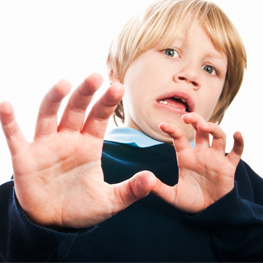
This may sound cynical, but bear with me. When someone pays you to help a child, you’re a good psychologist. When you try in vain to help a child, and then the child succeeds in spite - not because - of your help, you’re a good mother. I feel qualified to make this distinction because I’ve been both psychologist and mother.
When my son James was between the ages of two and four, he was afraid of hand dryers: those big metal contraptions in public restrooms that go “vvvvvv.” I was used to dealing with this sort of thing. People paid me to do it, so I fancied myself to be pretty good at it. I thought I could ease James’suffering. Also, to tell the whole story, James’public displays were making me look bad around town. Picture me in the paediatrician’s office, halfway under the roaring train set on a table, trying to unfasten James from one of the table’s legs: “It’s okay, man, there’s no hand dryer at the doctor’s office!”
At first, we could just avoid the hand dryers; James was in diapers. But by age three, James was toilet-trained. There’s only so much pee-peeing in a bush that polite society can tolerate.
I was ready to work my magic on James. As a psychologist, I trained in Cognitive-Behavioral Therapy (CBT), a very tidy approach to problem-solving. You identify a problem, and then change either what comes before, or what comes after. I first used CBT to train my cat, Walter, to use his scratching post. I put a container of treats on top of his post and gave him one every time he scratched it. It was humane and effective. My textbook made the point that a mollusk could be trained to clap its shell on command. ‘Wow,’ I thought at the time, ‘what can’t CBT do?’
We studied up in an attempt to make hand dryers friendlier. Did you know that, for some hand dryers, you put your hands inside the machine? We got well-acquainted with the one at our grocery store. My sweet husband made several hand dryers from shoeboxes, and mounted them in our bathrooms. James would use the bathroom, I’d hear a flush, then the splashing and then his little voice making a soft, earnest “vvvvvv” sound. One would think that a good year of focused intervention from a psychologist/mother would suffice. Not this time.
The height of our hand dryer horrors took place in a roadside McDonald’s the summer James was four. We were returning home from a hand-dryer-heavy trip and James was squirming around the booth. Instead of gullibly asking if he had to pee-pee, I just said, “Honey, let’s go use the potty.” Our family of four crept toward the family restroom, James clinging catlike to any obstacle in our path.
The closer we got, the louder he shouted. “No, I don’t have to go! Please, please don’t make me go in there! No hand dryer! I really don’t have to go!” I smiled apologetically at a woman as I peeled his hand off of her purse strap, but she didn’t smile back. Five minutes later, when we emerged disheveled and unrelieved from the restroom, James now desperately grabbing his crotch, my husband suggested we beat a hasty retreat in case someone had called the authorities. “A dingbat,” I said to my husband as we stumbled out of the underbrush where James had finally found relief, “that’s how our kids make me feel.”
When it ended, the success wasn’t mine. It was James’. Just as it should have been. One day, months after the road trip, James had to go to the doctor. On the way there in the car, we talked about his reward. I had some suggestions. “We could get ice cream. A donut? Go to the playground?” James just looked out the window.
As we pulled into a parking space he said wryly, still looking out the window, “No, mommy. You know what I really want?” I braced myself, thinking he was about to ask for a real backhoe loader or a Fender Stratocaster. “Mommy, I just want to go to the grocery store and use that hand dryer.”
And just like that, James’ biggest fear became a pleasure.
5 Tips for Easing Preschoolers’ Fears
1. Give your child a tool to combat the fear. James had a public restroom kit, including post-it notes to block automatic flush sensors and paper towels to use instead of the hand dryer.
2. Find photographs of the feared item in order to make it more familiar. We used Google Images to print out several different models of hand dryers.
3. Don’t avoid the fear entirely. Even though James didn’t use hand dryers, we visited public restrooms wherever we were, especially if we didn’t need to use them.
4. Be patient. Children don’t give up fears until they’re ready, and just like so much of parenting, the process is more important than the product.
5. It’s better to conquer a fear than to have never had one in the first place. See childhood fears as safe ways to practice coping with anxiety.
Lynn Adams, Ph.D., lives with her husband and two children. Find more of her work at lynnadamsphd.com.
Calgary’s Child Magazine © 2024 Calgary’s Child